Production of Polylactic Acid (PLA) : using a circular economy approach
VerifiedAdded on 2023/06/19
|22
|3958
|303
AI Summary
In this project we will discuss about polylactic acid (PLA) and below are the summaries point:-
Shemen Eco-Industries aims to tackle plastic pollution in Ghana by producing eco-friendly Polylactic Acid (PLA) using cassava as a raw material.
The company focuses on green manufacturing and developing low carbon dioxide products, aiming to reduce plastic waste and address climate change.
Shemen Eco-Industries also operates in real estate, providing tailored facilities and designing projects with a strong emphasis on sustainability and reducing carbon emissions.
Contribute Materials
Your contribution can guide someone’s learning journey. Share your
documents today.
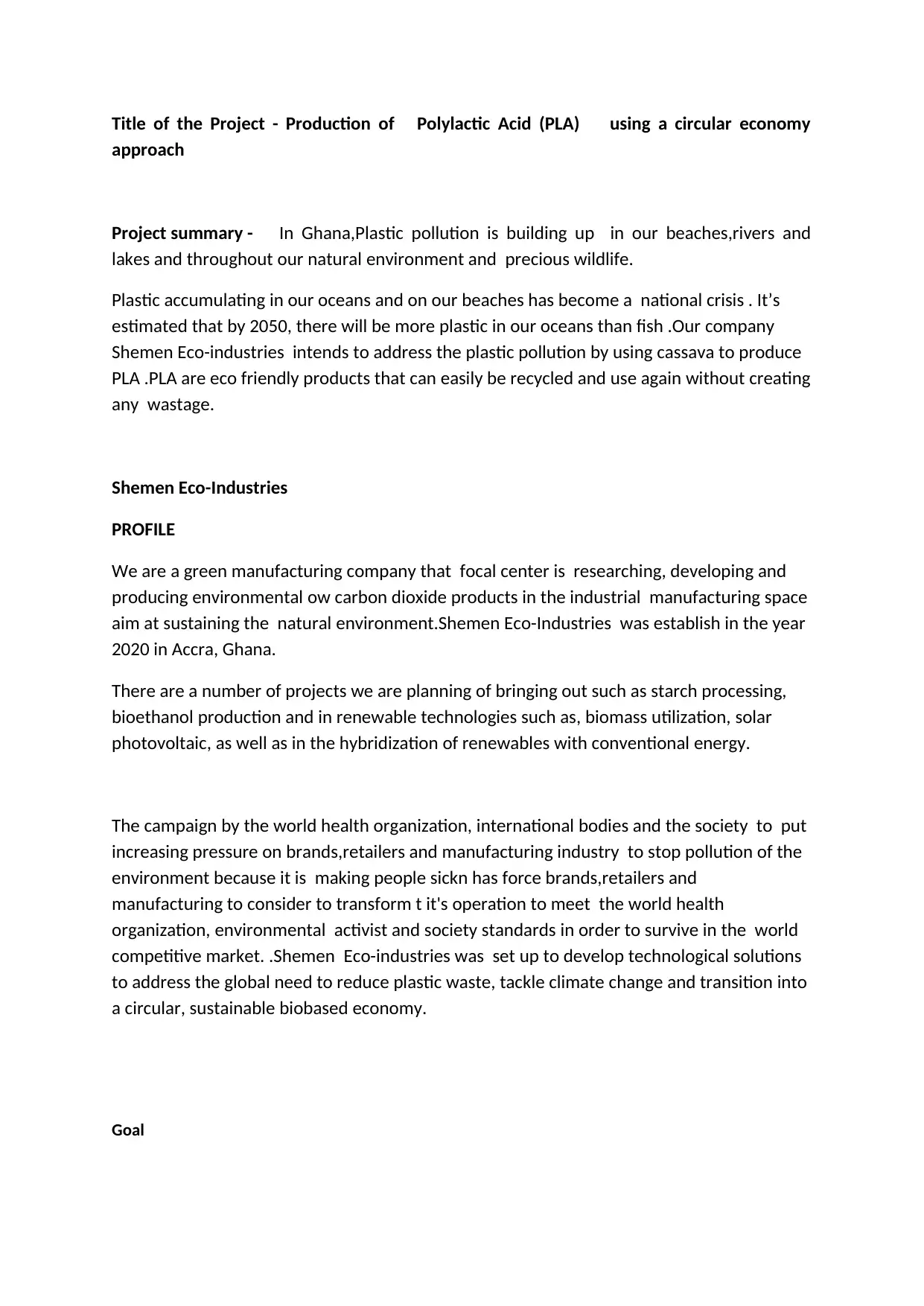
Title of the Project - Production of Polylactic Acid (PLA) using a circular economy
approach
Project summary - In Ghana,Plastic pollution is building up in our beaches,rivers and
lakes and throughout our natural environment and precious wildlife.
Plastic accumulating in our oceans and on our beaches has become a national crisis . It’s
estimated that by 2050, there will be more plastic in our oceans than fish .Our company
Shemen Eco-industries intends to address the plastic pollution by using cassava to produce
PLA .PLA are eco friendly products that can easily be recycled and use again without creating
any wastage.
Shemen Eco-Industries
PROFILE
We are a green manufacturing company that focal center is researching, developing and
producing environmental ow carbon dioxide products in the industrial manufacturing space
aim at sustaining the natural environment.Shemen Eco-Industries was establish in the year
2020 in Accra, Ghana.
There are a number of projects we are planning of bringing out such as starch processing,
bioethanol production and in renewable technologies such as, biomass utilization, solar
photovoltaic, as well as in the hybridization of renewables with conventional energy.
The campaign by the world health organization, international bodies and the society to put
increasing pressure on brands,retailers and manufacturing industry to stop pollution of the
environment because it is making people sickn has force brands,retailers and
manufacturing to consider to transform t it's operation to meet the world health
organization, environmental activist and society standards in order to survive in the world
competitive market. .Shemen Eco-industries was set up to develop technological solutions
to address the global need to reduce plastic waste, tackle climate change and transition into
a circular, sustainable biobased economy.
Goal
approach
Project summary - In Ghana,Plastic pollution is building up in our beaches,rivers and
lakes and throughout our natural environment and precious wildlife.
Plastic accumulating in our oceans and on our beaches has become a national crisis . It’s
estimated that by 2050, there will be more plastic in our oceans than fish .Our company
Shemen Eco-industries intends to address the plastic pollution by using cassava to produce
PLA .PLA are eco friendly products that can easily be recycled and use again without creating
any wastage.
Shemen Eco-Industries
PROFILE
We are a green manufacturing company that focal center is researching, developing and
producing environmental ow carbon dioxide products in the industrial manufacturing space
aim at sustaining the natural environment.Shemen Eco-Industries was establish in the year
2020 in Accra, Ghana.
There are a number of projects we are planning of bringing out such as starch processing,
bioethanol production and in renewable technologies such as, biomass utilization, solar
photovoltaic, as well as in the hybridization of renewables with conventional energy.
The campaign by the world health organization, international bodies and the society to put
increasing pressure on brands,retailers and manufacturing industry to stop pollution of the
environment because it is making people sickn has force brands,retailers and
manufacturing to consider to transform t it's operation to meet the world health
organization, environmental activist and society standards in order to survive in the world
competitive market. .Shemen Eco-industries was set up to develop technological solutions
to address the global need to reduce plastic waste, tackle climate change and transition into
a circular, sustainable biobased economy.
Goal
Secure Best Marks with AI Grader
Need help grading? Try our AI Grader for instant feedback on your assignments.
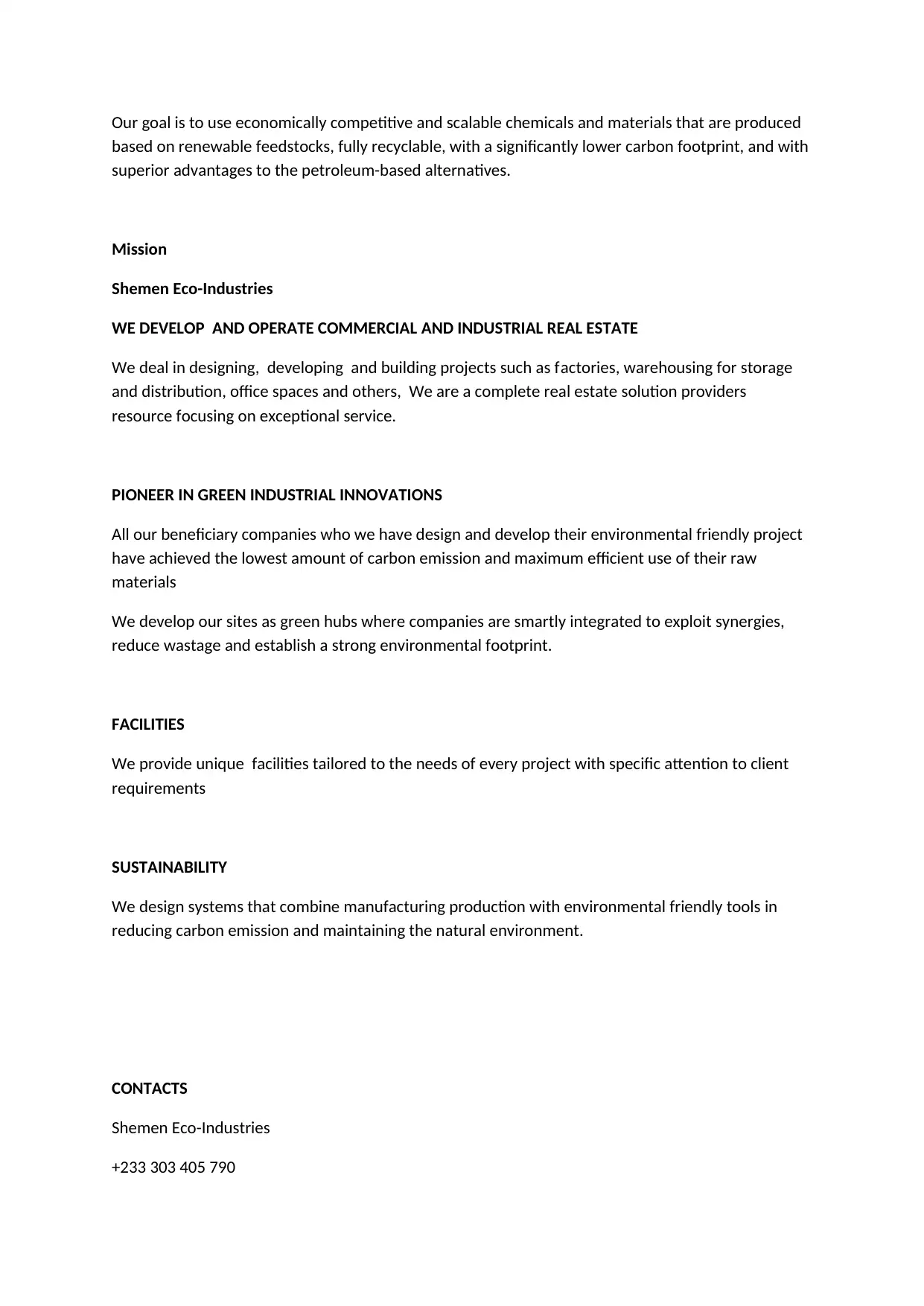
Our goal is to use economically competitive and scalable chemicals and materials that are produced
based on renewable feedstocks, fully recyclable, with a significantly lower carbon footprint, and with
superior advantages to the petroleum-based alternatives.
Mission
Shemen Eco-Industries
WE DEVELOP AND OPERATE COMMERCIAL AND INDUSTRIAL REAL ESTATE
We deal in designing, developing and building projects such as factories, warehousing for storage
and distribution, office spaces and others, We are a complete real estate solution providers
resource focusing on exceptional service.
PIONEER IN GREEN INDUSTRIAL INNOVATIONS
All our beneficiary companies who we have design and develop their environmental friendly project
have achieved the lowest amount of carbon emission and maximum efficient use of their raw
materials
We develop our sites as green hubs where companies are smartly integrated to exploit synergies,
reduce wastage and establish a strong environmental footprint.
FACILITIES
We provide unique facilities tailored to the needs of every project with specific attention to client
requirements
SUSTAINABILITY
We design systems that combine manufacturing production with environmental friendly tools in
reducing carbon emission and maintaining the natural environment.
CONTACTS
Shemen Eco-Industries
+233 303 405 790
based on renewable feedstocks, fully recyclable, with a significantly lower carbon footprint, and with
superior advantages to the petroleum-based alternatives.
Mission
Shemen Eco-Industries
WE DEVELOP AND OPERATE COMMERCIAL AND INDUSTRIAL REAL ESTATE
We deal in designing, developing and building projects such as factories, warehousing for storage
and distribution, office spaces and others, We are a complete real estate solution providers
resource focusing on exceptional service.
PIONEER IN GREEN INDUSTRIAL INNOVATIONS
All our beneficiary companies who we have design and develop their environmental friendly project
have achieved the lowest amount of carbon emission and maximum efficient use of their raw
materials
We develop our sites as green hubs where companies are smartly integrated to exploit synergies,
reduce wastage and establish a strong environmental footprint.
FACILITIES
We provide unique facilities tailored to the needs of every project with specific attention to client
requirements
SUSTAINABILITY
We design systems that combine manufacturing production with environmental friendly tools in
reducing carbon emission and maintaining the natural environment.
CONTACTS
Shemen Eco-Industries
+233 303 405 790
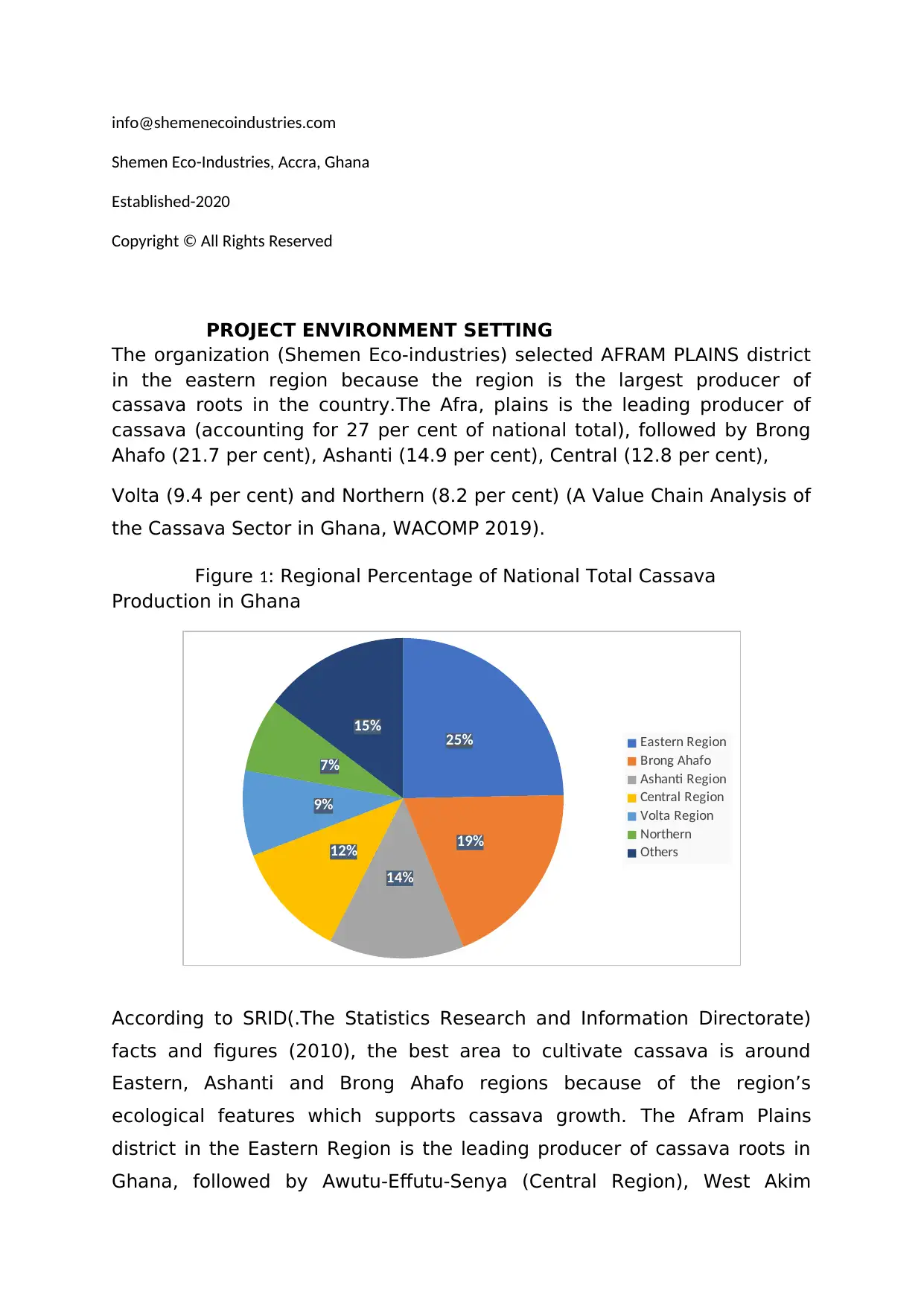
info@shemenecoindustries.com
Shemen Eco-Industries, Accra, Ghana
Established-2020
Copyright © All Rights Reserved
PROJECT ENVIRONMENT SETTING
The organization (Shemen Eco-industries) selected AFRAM PLAINS district
in the eastern region because the region is the largest producer of
cassava roots in the country.The Afra, plains is the leading producer of
cassava (accounting for 27 per cent of national total), followed by Brong
Ahafo (21.7 per cent), Ashanti (14.9 per cent), Central (12.8 per cent),
Volta (9.4 per cent) and Northern (8.2 per cent) (A Value Chain Analysis of
the Cassava Sector in Ghana, WACOMP 2019).
Figure 1: Regional Percentage of National Total Cassava
Production in Ghana
25%
19%
14%
12%
9%
7%
15%
Eastern Region
Brong Ahafo
Ashanti Region
Central Region
Volta Region
Northern
Others
According to SRID(.The Statistics Research and Information Directorate)
facts and figures (2010), the best area to cultivate cassava is around
Eastern, Ashanti and Brong Ahafo regions because of the region’s
ecological features which supports cassava growth. The Afram Plains
district in the Eastern Region is the leading producer of cassava roots in
Ghana, followed by Awutu-Effutu-Senya (Central Region), West Akim
Shemen Eco-Industries, Accra, Ghana
Established-2020
Copyright © All Rights Reserved
PROJECT ENVIRONMENT SETTING
The organization (Shemen Eco-industries) selected AFRAM PLAINS district
in the eastern region because the region is the largest producer of
cassava roots in the country.The Afra, plains is the leading producer of
cassava (accounting for 27 per cent of national total), followed by Brong
Ahafo (21.7 per cent), Ashanti (14.9 per cent), Central (12.8 per cent),
Volta (9.4 per cent) and Northern (8.2 per cent) (A Value Chain Analysis of
the Cassava Sector in Ghana, WACOMP 2019).
Figure 1: Regional Percentage of National Total Cassava
Production in Ghana
25%
19%
14%
12%
9%
7%
15%
Eastern Region
Brong Ahafo
Ashanti Region
Central Region
Volta Region
Northern
Others
According to SRID(.The Statistics Research and Information Directorate)
facts and figures (2010), the best area to cultivate cassava is around
Eastern, Ashanti and Brong Ahafo regions because of the region’s
ecological features which supports cassava growth. The Afram Plains
district in the Eastern Region is the leading producer of cassava roots in
Ghana, followed by Awutu-Effutu-Senya (Central Region), West Akim

(Eastern Region),Fanteakwa (Eastern Region), Atebubu Amantin (Bono
East Region), Twifo Hemang Lower Denkyira (Central Region), West Gonja
(Savannah Region), Kwahu West (Eastern Region), Atiwa (Eastern Region)
and Komenda Edina Eguafo Abirem (Central Region) (A Value Chain
Analysis of the Cassava Sector in Ghana, WACOMP 2019).
PROJECT OBJECTIVES
1. Job creation: At a full scale the project is expected to provide
direct employment for approximately 50 -200 people while employing
over 500 people indirectly.
2. Infrastructure development: As part of our production
development plan, we plan to develop water and power infrastructure that
in many instances will be benefit the neighbouring community.
3. Land Protection: The project will embark on an
EIA(Environmenal Impact Assessment) assessment to ascertain potential
environmental impact and mitigating measures of our project on the
community. This is in addition to the detailed ecology studies we will carry
out before identifying the land to acquire.
4. National Income: We will contribute to national income by
producing value-added cassava, which has the potential to revolutionize
Ghana's economy. Furthermore, local cassava starch manufacturing will
ensure that more of the additional value stays in the Ghanaian economy.
5. Pollution Reduction: Our factory will use best-in-class waste
management solutions to reduce pollution to the environment. We plan to
commission a bio gas plant that will use waste matter from our effluent
water as fuel as part of optimization of the project.
East Region), Twifo Hemang Lower Denkyira (Central Region), West Gonja
(Savannah Region), Kwahu West (Eastern Region), Atiwa (Eastern Region)
and Komenda Edina Eguafo Abirem (Central Region) (A Value Chain
Analysis of the Cassava Sector in Ghana, WACOMP 2019).
PROJECT OBJECTIVES
1. Job creation: At a full scale the project is expected to provide
direct employment for approximately 50 -200 people while employing
over 500 people indirectly.
2. Infrastructure development: As part of our production
development plan, we plan to develop water and power infrastructure that
in many instances will be benefit the neighbouring community.
3. Land Protection: The project will embark on an
EIA(Environmenal Impact Assessment) assessment to ascertain potential
environmental impact and mitigating measures of our project on the
community. This is in addition to the detailed ecology studies we will carry
out before identifying the land to acquire.
4. National Income: We will contribute to national income by
producing value-added cassava, which has the potential to revolutionize
Ghana's economy. Furthermore, local cassava starch manufacturing will
ensure that more of the additional value stays in the Ghanaian economy.
5. Pollution Reduction: Our factory will use best-in-class waste
management solutions to reduce pollution to the environment. We plan to
commission a bio gas plant that will use waste matter from our effluent
water as fuel as part of optimization of the project.
Secure Best Marks with AI Grader
Need help grading? Try our AI Grader for instant feedback on your assignments.

Project importance
.2 Project Benefits
1. Through training, apprenticeships, knowledge transfer and
best practices, employees, farmers and other stake holders will be able to
build their capacities. This will be a fulfilment of SDG 4
2. The project will employ substantial number of females to take
up vital positions in the cassava production and the processing factories in
fulfilment of SDG 5.
3. The project will ensure the use of clean and affordable energy
such as biogas and Solar PV Minigrid. Hence, a fulfilment of SDG 7.
4. Quality employment will be created within the bioethanol and
starch plants. Also, substantial economic opportunities will be created for
farmers. Hence, a fulfilment of SDG 8
5. The cassava farm will be fully mechanized and the starch and
bioethanol processing will be fully automated. This step will be in
alignment of SDG 9 – Industry, Innovation and Infrastructure.
Project priority
To address the problem of plastic waste that is suffocating the planet and
polluting the environment
Project break down
4.4 PLA Production Technology
.2 Project Benefits
1. Through training, apprenticeships, knowledge transfer and
best practices, employees, farmers and other stake holders will be able to
build their capacities. This will be a fulfilment of SDG 4
2. The project will employ substantial number of females to take
up vital positions in the cassava production and the processing factories in
fulfilment of SDG 5.
3. The project will ensure the use of clean and affordable energy
such as biogas and Solar PV Minigrid. Hence, a fulfilment of SDG 7.
4. Quality employment will be created within the bioethanol and
starch plants. Also, substantial economic opportunities will be created for
farmers. Hence, a fulfilment of SDG 8
5. The cassava farm will be fully mechanized and the starch and
bioethanol processing will be fully automated. This step will be in
alignment of SDG 9 – Industry, Innovation and Infrastructure.
Project priority
To address the problem of plastic waste that is suffocating the planet and
polluting the environment
Project break down
4.4 PLA Production Technology

Polylactic acid (PLA) is a transparent plastic produced from Glucose. As
the only commercial Technology of PLA bioplastic, the NatureWorks
production process called “Cargill Dow process” is applied in this study. As
shown in Figure 3, cassava roots are used as feedstock to produce PLA
resins. Cassava root produced in Thailand has 25 wt% starch content
which can convert to lactic acid with the weight ratio of 1.3 to 1 (TTSA,
2010). The expected production capacity of PLA in Thailand was estimated
from the availability of cassava production studied by the NIA (Suppasri
and Sermcheep, 2010). By transforming cassava starch to glucose, to
lactic acid, and to PLA, cassava meals and gypsum are the two main by-
products. In the whole production process, certain amounts of wastewater
are also produced.
a. Starch Production
In order to meet its annual PLA production, the project would require 30,000 MT of starch,
which would be sourced from its own starch factory. Figure 3 illustrates how the starch
would be sourced.
i. Starch Extraction Process
Cassava starch technology has undergone major transformation from subsistence to
commercial production. This is in order to meet global starch demand and compete
favourably with starch from other sources such as maize and potato. The technological
transformation is more pronounced in Asia and Latin America, especially Thailand and
Brazil. The starch extraction process from cassava roots is outlined below:
.Figure 4:
THE PROJECT Break down
the only commercial Technology of PLA bioplastic, the NatureWorks
production process called “Cargill Dow process” is applied in this study. As
shown in Figure 3, cassava roots are used as feedstock to produce PLA
resins. Cassava root produced in Thailand has 25 wt% starch content
which can convert to lactic acid with the weight ratio of 1.3 to 1 (TTSA,
2010). The expected production capacity of PLA in Thailand was estimated
from the availability of cassava production studied by the NIA (Suppasri
and Sermcheep, 2010). By transforming cassava starch to glucose, to
lactic acid, and to PLA, cassava meals and gypsum are the two main by-
products. In the whole production process, certain amounts of wastewater
are also produced.
a. Starch Production
In order to meet its annual PLA production, the project would require 30,000 MT of starch,
which would be sourced from its own starch factory. Figure 3 illustrates how the starch
would be sourced.
i. Starch Extraction Process
Cassava starch technology has undergone major transformation from subsistence to
commercial production. This is in order to meet global starch demand and compete
favourably with starch from other sources such as maize and potato. The technological
transformation is more pronounced in Asia and Latin America, especially Thailand and
Brazil. The starch extraction process from cassava roots is outlined below:
.Figure 4:
THE PROJECT Break down
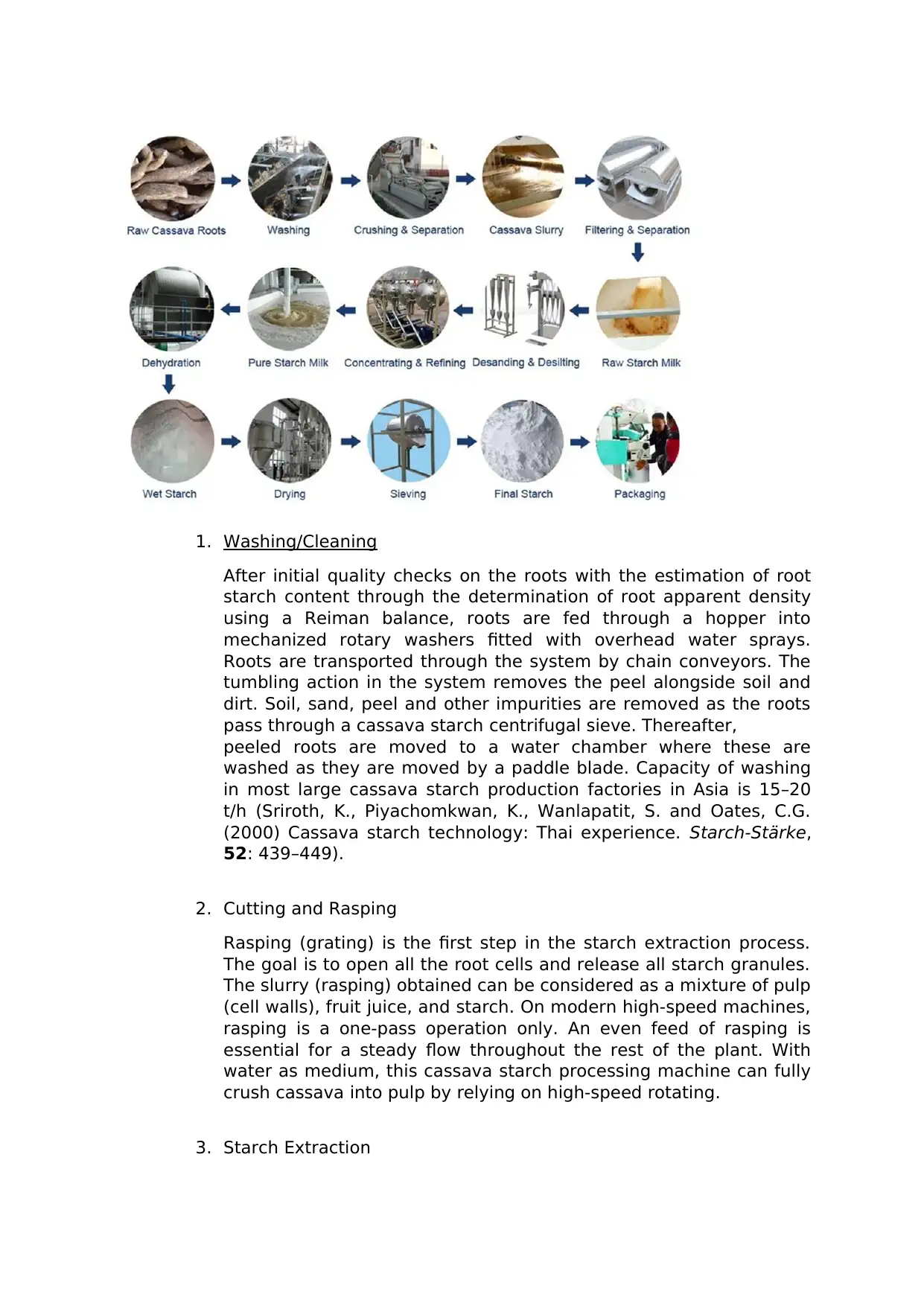
1. Washing/Cleaning
After initial quality checks on the roots with the estimation of root
starch content through the determination of root apparent density
using a Reiman balance, roots are fed through a hopper into
mechanized rotary washers fitted with overhead water sprays.
Roots are transported through the system by chain conveyors. The
tumbling action in the system removes the peel alongside soil and
dirt. Soil, sand, peel and other impurities are removed as the roots
pass through a cassava starch centrifugal sieve. Thereafter,
peeled roots are moved to a water chamber where these are
washed as they are moved by a paddle blade. Capacity of washing
in most large cassava starch production factories in Asia is 15–20
t/h (Sriroth, K., Piyachomkwan, K., Wanlapatit, S. and Oates, C.G.
(2000) Cassava starch technology: Thai experience. Starch-Stärke,
52: 439–449).
2. Cutting and Rasping
Rasping (grating) is the first step in the starch extraction process.
The goal is to open all the root cells and release all starch granules.
The slurry (rasping) obtained can be considered as a mixture of pulp
(cell walls), fruit juice, and starch. On modern high-speed machines,
rasping is a one-pass operation only. An even feed of rasping is
essential for a steady flow throughout the rest of the plant. With
water as medium, this cassava starch processing machine can fully
crush cassava into pulp by relying on high-speed rotating.
3. Starch Extraction
After initial quality checks on the roots with the estimation of root
starch content through the determination of root apparent density
using a Reiman balance, roots are fed through a hopper into
mechanized rotary washers fitted with overhead water sprays.
Roots are transported through the system by chain conveyors. The
tumbling action in the system removes the peel alongside soil and
dirt. Soil, sand, peel and other impurities are removed as the roots
pass through a cassava starch centrifugal sieve. Thereafter,
peeled roots are moved to a water chamber where these are
washed as they are moved by a paddle blade. Capacity of washing
in most large cassava starch production factories in Asia is 15–20
t/h (Sriroth, K., Piyachomkwan, K., Wanlapatit, S. and Oates, C.G.
(2000) Cassava starch technology: Thai experience. Starch-Stärke,
52: 439–449).
2. Cutting and Rasping
Rasping (grating) is the first step in the starch extraction process.
The goal is to open all the root cells and release all starch granules.
The slurry (rasping) obtained can be considered as a mixture of pulp
(cell walls), fruit juice, and starch. On modern high-speed machines,
rasping is a one-pass operation only. An even feed of rasping is
essential for a steady flow throughout the rest of the plant. With
water as medium, this cassava starch processing machine can fully
crush cassava into pulp by relying on high-speed rotating.
3. Starch Extraction
Paraphrase This Document
Need a fresh take? Get an instant paraphrase of this document with our AI Paraphraser
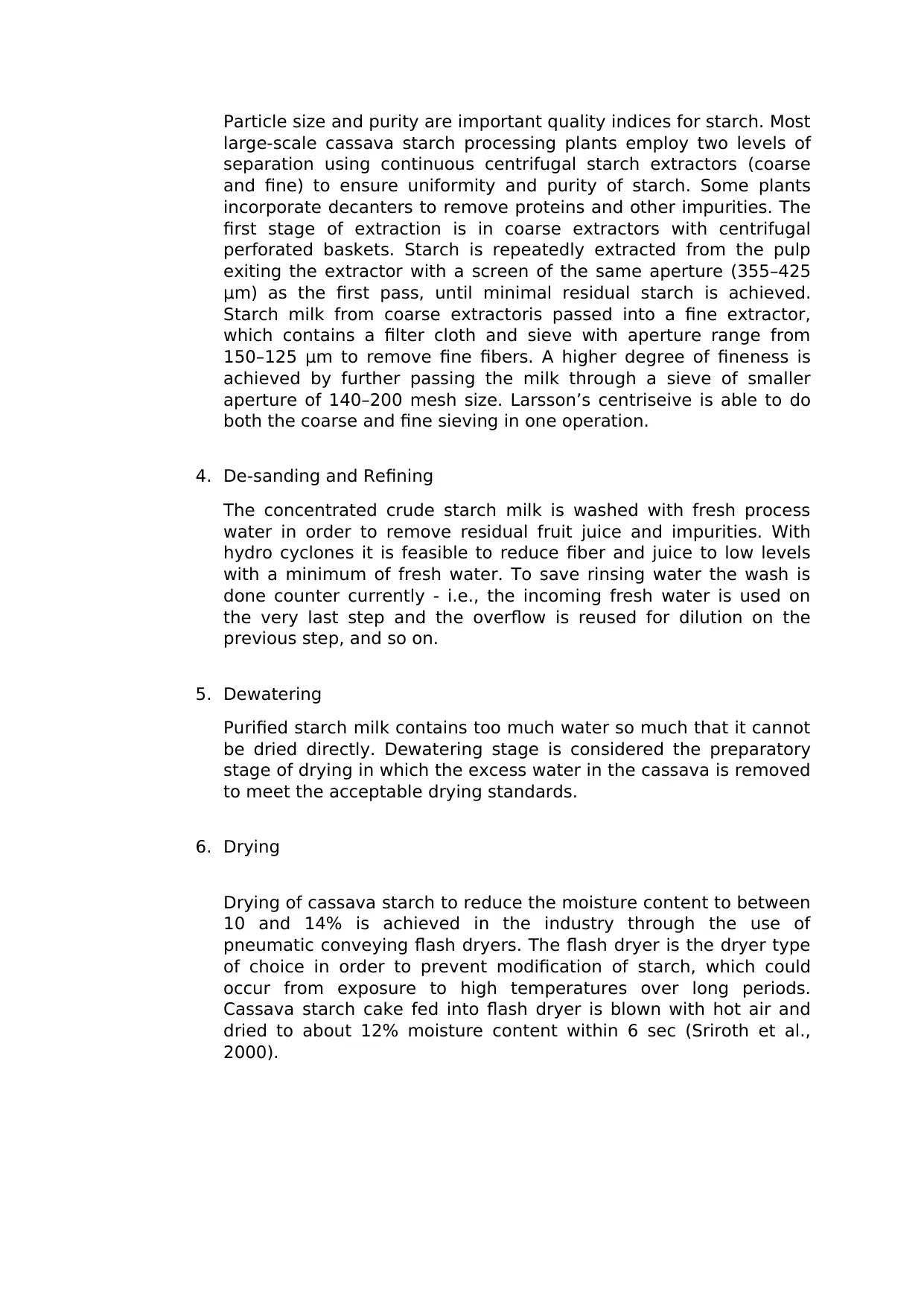
Particle size and purity are important quality indices for starch. Most
large-scale cassava starch processing plants employ two levels of
separation using continuous centrifugal starch extractors (coarse
and fine) to ensure uniformity and purity of starch. Some plants
incorporate decanters to remove proteins and other impurities. The
first stage of extraction is in coarse extractors with centrifugal
perforated baskets. Starch is repeatedly extracted from the pulp
exiting the extractor with a screen of the same aperture (355–425
μm) as the first pass, until minimal residual starch is achieved.
Starch milk from coarse extractoris passed into a fine extractor,
which contains a filter cloth and sieve with aperture range from
150–125 μm to remove fine fibers. A higher degree of fineness is
achieved by further passing the milk through a sieve of smaller
aperture of 140–200 mesh size. Larsson’s centriseive is able to do
both the coarse and fine sieving in one operation.
4. De-sanding and Refining
The concentrated crude starch milk is washed with fresh process
water in order to remove residual fruit juice and impurities. With
hydro cyclones it is feasible to reduce fiber and juice to low levels
with a minimum of fresh water. To save rinsing water the wash is
done counter currently - i.e., the incoming fresh water is used on
the very last step and the overflow is reused for dilution on the
previous step, and so on.
5. Dewatering
Purified starch milk contains too much water so much that it cannot
be dried directly. Dewatering stage is considered the preparatory
stage of drying in which the excess water in the cassava is removed
to meet the acceptable drying standards.
6. Drying
Drying of cassava starch to reduce the moisture content to between
10 and 14% is achieved in the industry through the use of
pneumatic conveying flash dryers. The flash dryer is the dryer type
of choice in order to prevent modification of starch, which could
occur from exposure to high temperatures over long periods.
Cassava starch cake fed into flash dryer is blown with hot air and
dried to about 12% moisture content within 6 sec (Sriroth et al.,
2000).
large-scale cassava starch processing plants employ two levels of
separation using continuous centrifugal starch extractors (coarse
and fine) to ensure uniformity and purity of starch. Some plants
incorporate decanters to remove proteins and other impurities. The
first stage of extraction is in coarse extractors with centrifugal
perforated baskets. Starch is repeatedly extracted from the pulp
exiting the extractor with a screen of the same aperture (355–425
μm) as the first pass, until minimal residual starch is achieved.
Starch milk from coarse extractoris passed into a fine extractor,
which contains a filter cloth and sieve with aperture range from
150–125 μm to remove fine fibers. A higher degree of fineness is
achieved by further passing the milk through a sieve of smaller
aperture of 140–200 mesh size. Larsson’s centriseive is able to do
both the coarse and fine sieving in one operation.
4. De-sanding and Refining
The concentrated crude starch milk is washed with fresh process
water in order to remove residual fruit juice and impurities. With
hydro cyclones it is feasible to reduce fiber and juice to low levels
with a minimum of fresh water. To save rinsing water the wash is
done counter currently - i.e., the incoming fresh water is used on
the very last step and the overflow is reused for dilution on the
previous step, and so on.
5. Dewatering
Purified starch milk contains too much water so much that it cannot
be dried directly. Dewatering stage is considered the preparatory
stage of drying in which the excess water in the cassava is removed
to meet the acceptable drying standards.
6. Drying
Drying of cassava starch to reduce the moisture content to between
10 and 14% is achieved in the industry through the use of
pneumatic conveying flash dryers. The flash dryer is the dryer type
of choice in order to prevent modification of starch, which could
occur from exposure to high temperatures over long periods.
Cassava starch cake fed into flash dryer is blown with hot air and
dried to about 12% moisture content within 6 sec (Sriroth et al.,
2000).

A detailed overview and analysis of
aspects of the project using project
management concepts, tools, and
techniques taught in this subject; some
of them may be more important to your
particular project than others.
You should focus your analysis on at
least three topics from the following
list:
Developing the project plan,
Scheduling project resources and costs
of project risk and Change control of
monitoring project time.
aspects of the project using project
management concepts, tools, and
techniques taught in this subject; some
of them may be more important to your
particular project than others.
You should focus your analysis on at
least three topics from the following
list:
Developing the project plan,
Scheduling project resources and costs
of project risk and Change control of
monitoring project time.

Programme and project management tools
and techniques.
The SWOT analysis was use for this project..
SWOT - strengths, weaknesses,
opportunities, threats
Compares the effects of strengths,
weaknesses, opportunities and threats on
the potential outcome.
A SWOT analysis can be used to draw out
the threats and opportunities facing a
programme or project. It has the advantage
of being quick to implement and is readily
understood. Analysis of the strengths,
weaknesses, opportunities and threats
brings together the results of internal
business analysis and external
environmental analysis. Common and
beneficial applications of SWOT are gaining
and techniques.
The SWOT analysis was use for this project..
SWOT - strengths, weaknesses,
opportunities, threats
Compares the effects of strengths,
weaknesses, opportunities and threats on
the potential outcome.
A SWOT analysis can be used to draw out
the threats and opportunities facing a
programme or project. It has the advantage
of being quick to implement and is readily
understood. Analysis of the strengths,
weaknesses, opportunities and threats
brings together the results of internal
business analysis and external
environmental analysis. Common and
beneficial applications of SWOT are gaining
Secure Best Marks with AI Grader
Need help grading? Try our AI Grader for instant feedback on your assignments.
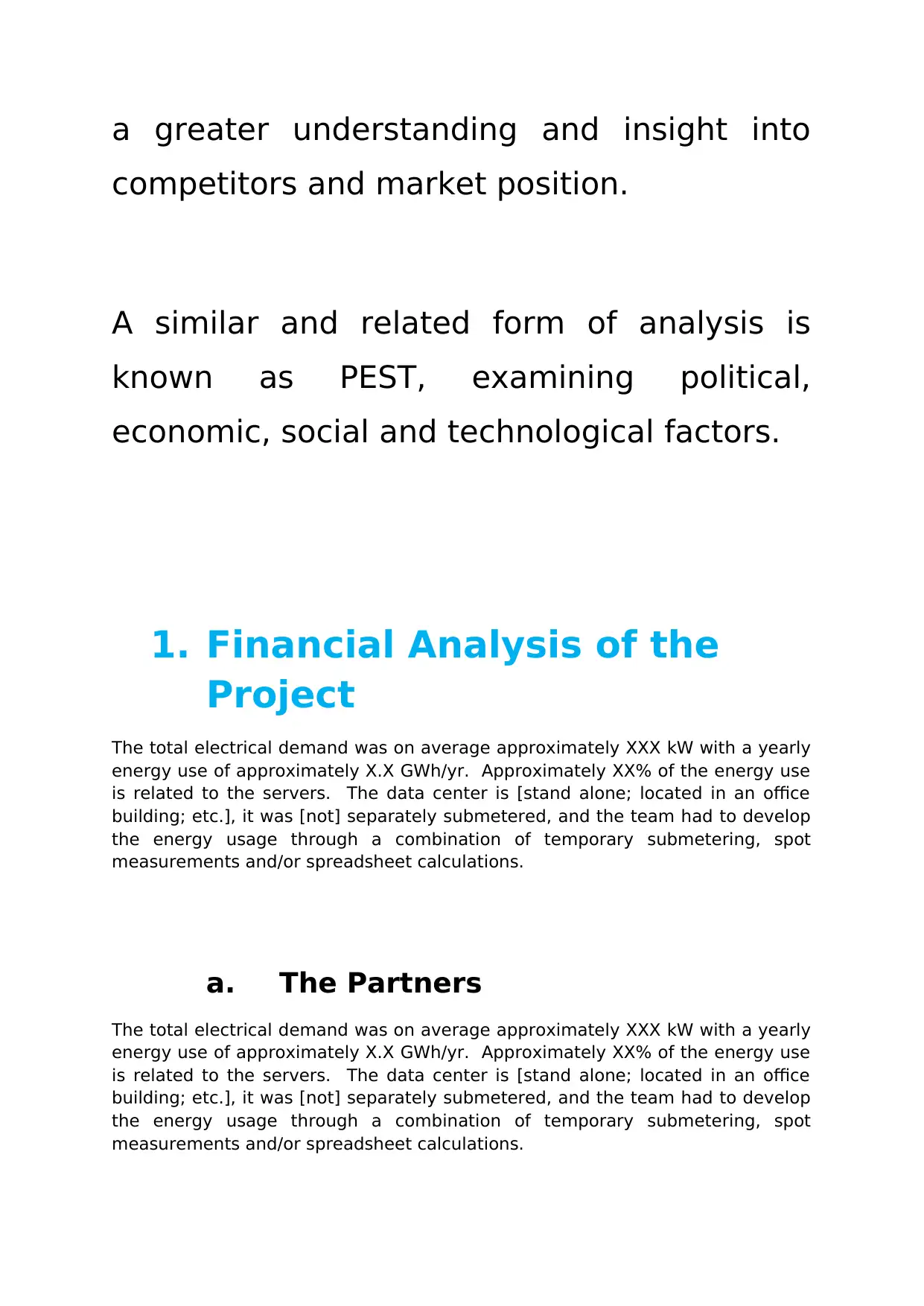
a greater understanding and insight into
competitors and market position.
A similar and related form of analysis is
known as PEST, examining political,
economic, social and technological factors.
1. Financial Analysis of the
Project
The total electrical demand was on average approximately XXX kW with a yearly
energy use of approximately X.X GWh/yr. Approximately XX% of the energy use
is related to the servers. The data center is [stand alone; located in an office
building; etc.], it was [not] separately submetered, and the team had to develop
the energy usage through a combination of temporary submetering, spot
measurements and/or spreadsheet calculations.
a. The Partners
The total electrical demand was on average approximately XXX kW with a yearly
energy use of approximately X.X GWh/yr. Approximately XX% of the energy use
is related to the servers. The data center is [stand alone; located in an office
building; etc.], it was [not] separately submetered, and the team had to develop
the energy usage through a combination of temporary submetering, spot
measurements and/or spreadsheet calculations.
competitors and market position.
A similar and related form of analysis is
known as PEST, examining political,
economic, social and technological factors.
1. Financial Analysis of the
Project
The total electrical demand was on average approximately XXX kW with a yearly
energy use of approximately X.X GWh/yr. Approximately XX% of the energy use
is related to the servers. The data center is [stand alone; located in an office
building; etc.], it was [not] separately submetered, and the team had to develop
the energy usage through a combination of temporary submetering, spot
measurements and/or spreadsheet calculations.
a. The Partners
The total electrical demand was on average approximately XXX kW with a yearly
energy use of approximately X.X GWh/yr. Approximately XX% of the energy use
is related to the servers. The data center is [stand alone; located in an office
building; etc.], it was [not] separately submetered, and the team had to develop
the energy usage through a combination of temporary submetering, spot
measurements and/or spreadsheet calculations.
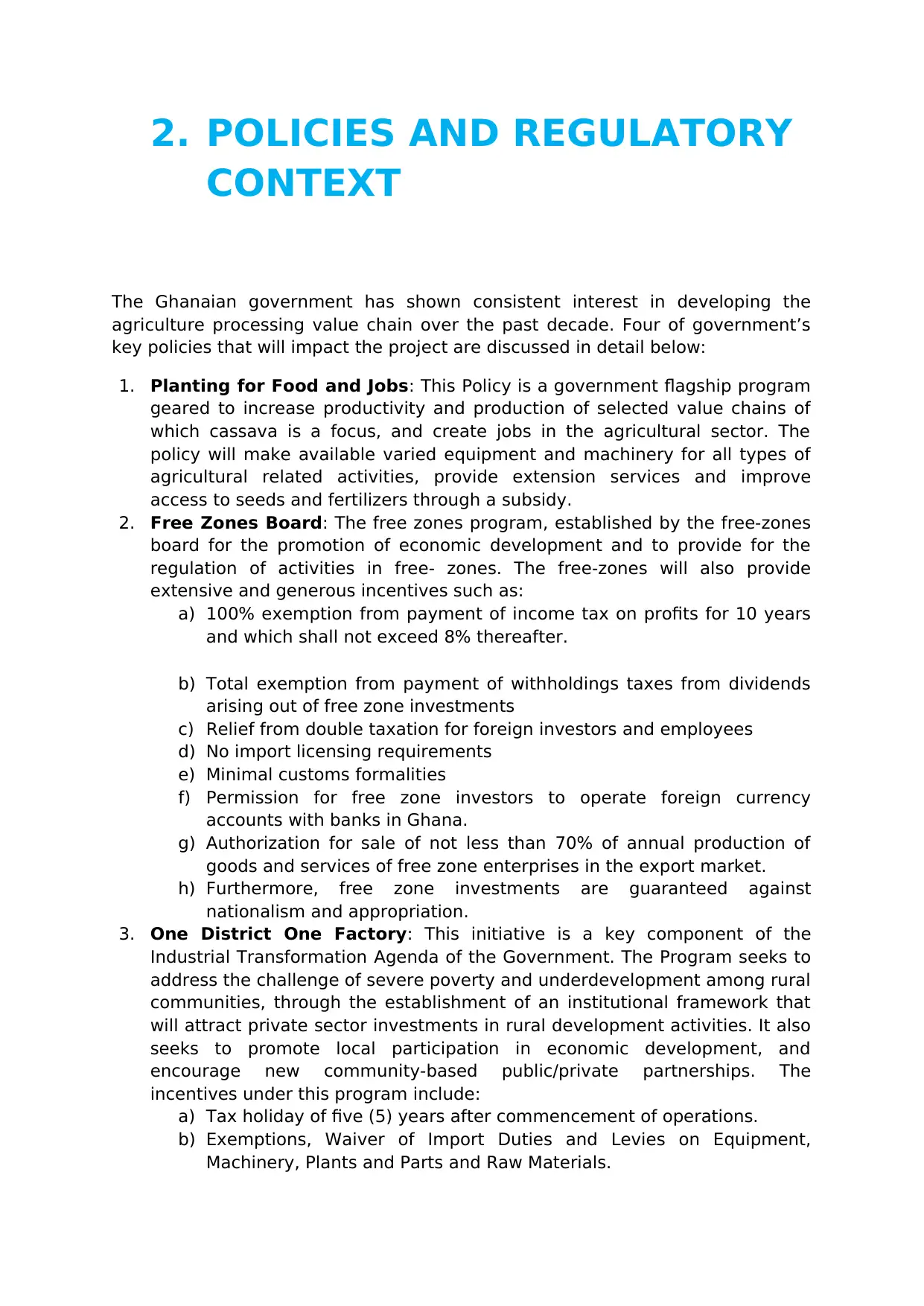
2. POLICIES AND REGULATORY
CONTEXT
The Ghanaian government has shown consistent interest in developing the
agriculture processing value chain over the past decade. Four of government’s
key policies that will impact the project are discussed in detail below:
1. Planting for Food and Jobs: This Policy is a government flagship program
geared to increase productivity and production of selected value chains of
which cassava is a focus, and create jobs in the agricultural sector. The
policy will make available varied equipment and machinery for all types of
agricultural related activities, provide extension services and improve
access to seeds and fertilizers through a subsidy.
2. Free Zones Board: The free zones program, established by the free-zones
board for the promotion of economic development and to provide for the
regulation of activities in free- zones. The free-zones will also provide
extensive and generous incentives such as:
a) 100% exemption from payment of income tax on profits for 10 years
and which shall not exceed 8% thereafter.
b) Total exemption from payment of withholdings taxes from dividends
arising out of free zone investments
c) Relief from double taxation for foreign investors and employees
d) No import licensing requirements
e) Minimal customs formalities
f) Permission for free zone investors to operate foreign currency
accounts with banks in Ghana.
g) Authorization for sale of not less than 70% of annual production of
goods and services of free zone enterprises in the export market.
h) Furthermore, free zone investments are guaranteed against
nationalism and appropriation.
3. One District One Factory: This initiative is a key component of the
Industrial Transformation Agenda of the Government. The Program seeks to
address the challenge of severe poverty and underdevelopment among rural
communities, through the establishment of an institutional framework that
will attract private sector investments in rural development activities. It also
seeks to promote local participation in economic development, and
encourage new community-based public/private partnerships. The
incentives under this program include:
a) Tax holiday of five (5) years after commencement of operations.
b) Exemptions, Waiver of Import Duties and Levies on Equipment,
Machinery, Plants and Parts and Raw Materials.
CONTEXT
The Ghanaian government has shown consistent interest in developing the
agriculture processing value chain over the past decade. Four of government’s
key policies that will impact the project are discussed in detail below:
1. Planting for Food and Jobs: This Policy is a government flagship program
geared to increase productivity and production of selected value chains of
which cassava is a focus, and create jobs in the agricultural sector. The
policy will make available varied equipment and machinery for all types of
agricultural related activities, provide extension services and improve
access to seeds and fertilizers through a subsidy.
2. Free Zones Board: The free zones program, established by the free-zones
board for the promotion of economic development and to provide for the
regulation of activities in free- zones. The free-zones will also provide
extensive and generous incentives such as:
a) 100% exemption from payment of income tax on profits for 10 years
and which shall not exceed 8% thereafter.
b) Total exemption from payment of withholdings taxes from dividends
arising out of free zone investments
c) Relief from double taxation for foreign investors and employees
d) No import licensing requirements
e) Minimal customs formalities
f) Permission for free zone investors to operate foreign currency
accounts with banks in Ghana.
g) Authorization for sale of not less than 70% of annual production of
goods and services of free zone enterprises in the export market.
h) Furthermore, free zone investments are guaranteed against
nationalism and appropriation.
3. One District One Factory: This initiative is a key component of the
Industrial Transformation Agenda of the Government. The Program seeks to
address the challenge of severe poverty and underdevelopment among rural
communities, through the establishment of an institutional framework that
will attract private sector investments in rural development activities. It also
seeks to promote local participation in economic development, and
encourage new community-based public/private partnerships. The
incentives under this program include:
a) Tax holiday of five (5) years after commencement of operations.
b) Exemptions, Waiver of Import Duties and Levies on Equipment,
Machinery, Plants and Parts and Raw Materials.

c) Industrial plants, machinery or equipment and parts imported for IDIF
are exempted from payment of levies and Customs Import Duty under
HS Codes chapter 82, 84, 85, and 98.
d) A special credit risk insurance guarantee scheme shall be established
for 1D1F companies.
4. The Ghana Investment Promotion Center (GIPC) is the Government’s
mandated institution for promoting investment. There are a number of laws
and regulations guiding investments in the agriculture sector which include
but not limited to the following:
a) The Companies Act, 1963 (Act 179)
b) Ghana Free Zones Act, 1995 (Act 505)
c) Forestry Commission Act, 1999 (Act 571)
d) Environmental Conservation Act
e) The Labour Act, 2003 (Act 651)
f) Land Act, 2020
. RISK ASSESSMENT
Limited use of high-quality inputs has been
a key impediment to growth of the cassava
sector, as the major reason for low yields.
Low productivity is a constraint to
commercialization because it drives high
costs of sourcing raw material and problems
securing sufficient supply. This project will
put measures in place to ensure the timely
supply of inputs and the use of best
agronomic practices to reduce this risk.
are exempted from payment of levies and Customs Import Duty under
HS Codes chapter 82, 84, 85, and 98.
d) A special credit risk insurance guarantee scheme shall be established
for 1D1F companies.
4. The Ghana Investment Promotion Center (GIPC) is the Government’s
mandated institution for promoting investment. There are a number of laws
and regulations guiding investments in the agriculture sector which include
but not limited to the following:
a) The Companies Act, 1963 (Act 179)
b) Ghana Free Zones Act, 1995 (Act 505)
c) Forestry Commission Act, 1999 (Act 571)
d) Environmental Conservation Act
e) The Labour Act, 2003 (Act 651)
f) Land Act, 2020
. RISK ASSESSMENT
Limited use of high-quality inputs has been
a key impediment to growth of the cassava
sector, as the major reason for low yields.
Low productivity is a constraint to
commercialization because it drives high
costs of sourcing raw material and problems
securing sufficient supply. This project will
put measures in place to ensure the timely
supply of inputs and the use of best
agronomic practices to reduce this risk.
Paraphrase This Document
Need a fresh take? Get an instant paraphrase of this document with our AI Paraphraser
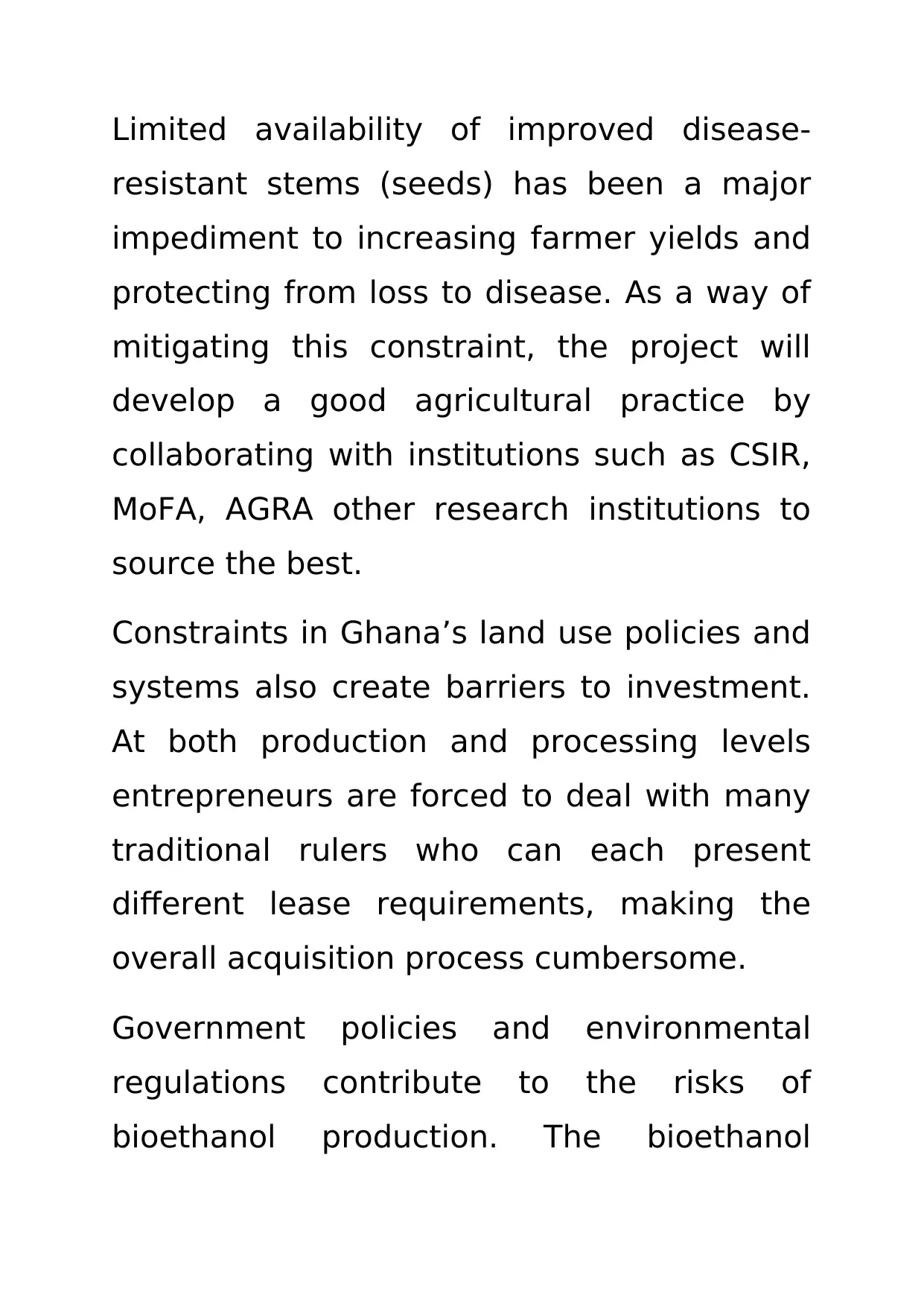
Limited availability of improved disease-
resistant stems (seeds) has been a major
impediment to increasing farmer yields and
protecting from loss to disease. As a way of
mitigating this constraint, the project will
develop a good agricultural practice by
collaborating with institutions such as CSIR,
MoFA, AGRA other research institutions to
source the best.
Constraints in Ghana’s land use policies and
systems also create barriers to investment.
At both production and processing levels
entrepreneurs are forced to deal with many
traditional rulers who can each present
different lease requirements, making the
overall acquisition process cumbersome.
Government policies and environmental
regulations contribute to the risks of
bioethanol production. The bioethanol
resistant stems (seeds) has been a major
impediment to increasing farmer yields and
protecting from loss to disease. As a way of
mitigating this constraint, the project will
develop a good agricultural practice by
collaborating with institutions such as CSIR,
MoFA, AGRA other research institutions to
source the best.
Constraints in Ghana’s land use policies and
systems also create barriers to investment.
At both production and processing levels
entrepreneurs are forced to deal with many
traditional rulers who can each present
different lease requirements, making the
overall acquisition process cumbersome.
Government policies and environmental
regulations contribute to the risks of
bioethanol production. The bioethanol
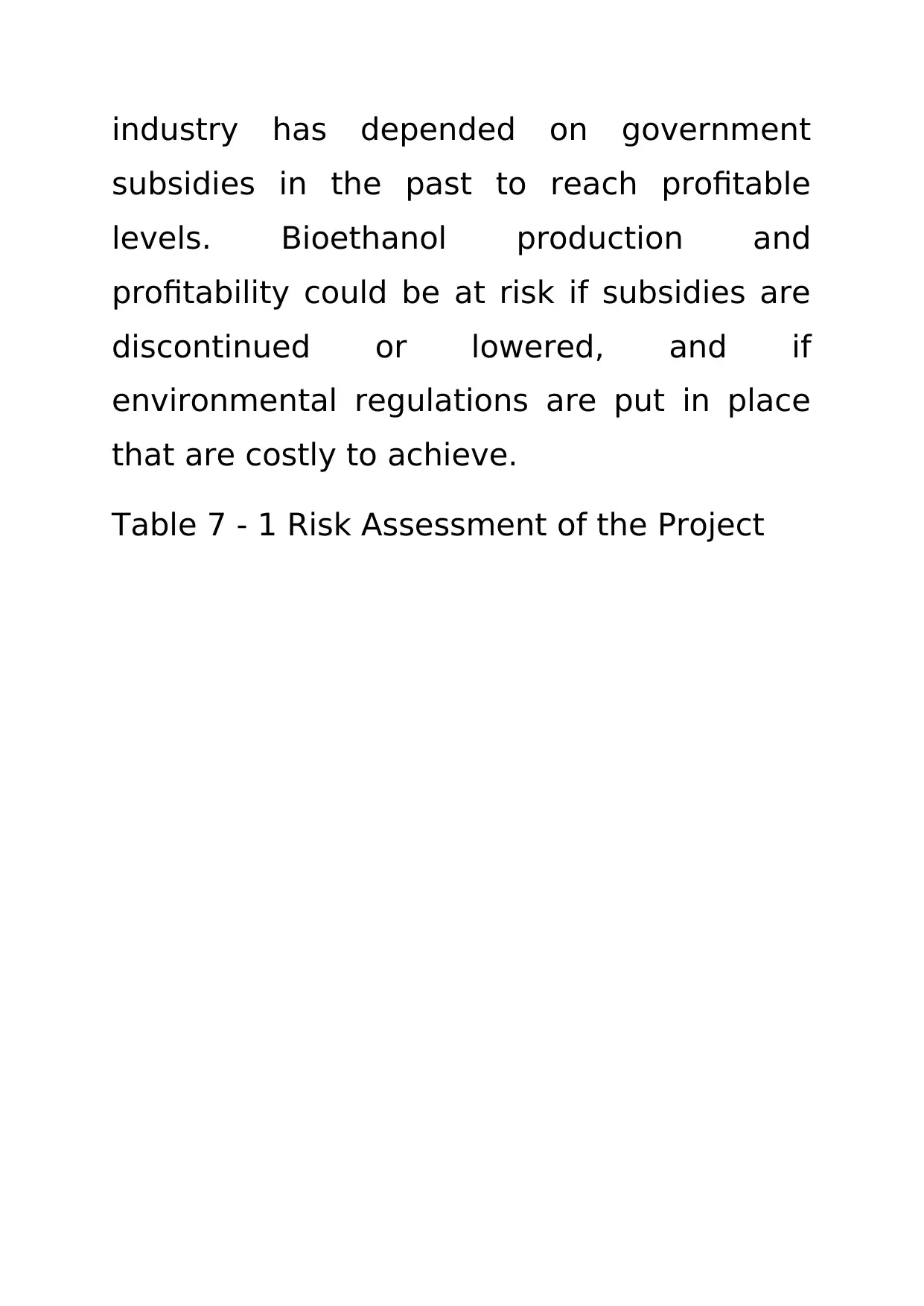
industry has depended on government
subsidies in the past to reach profitable
levels. Bioethanol production and
profitability could be at risk if subsidies are
discontinued or lowered, and if
environmental regulations are put in place
that are costly to achieve.
Table 7 - 1 Risk Assessment of the Project
subsidies in the past to reach profitable
levels. Bioethanol production and
profitability could be at risk if subsidies are
discontinued or lowered, and if
environmental regulations are put in place
that are costly to achieve.
Table 7 - 1 Risk Assessment of the Project
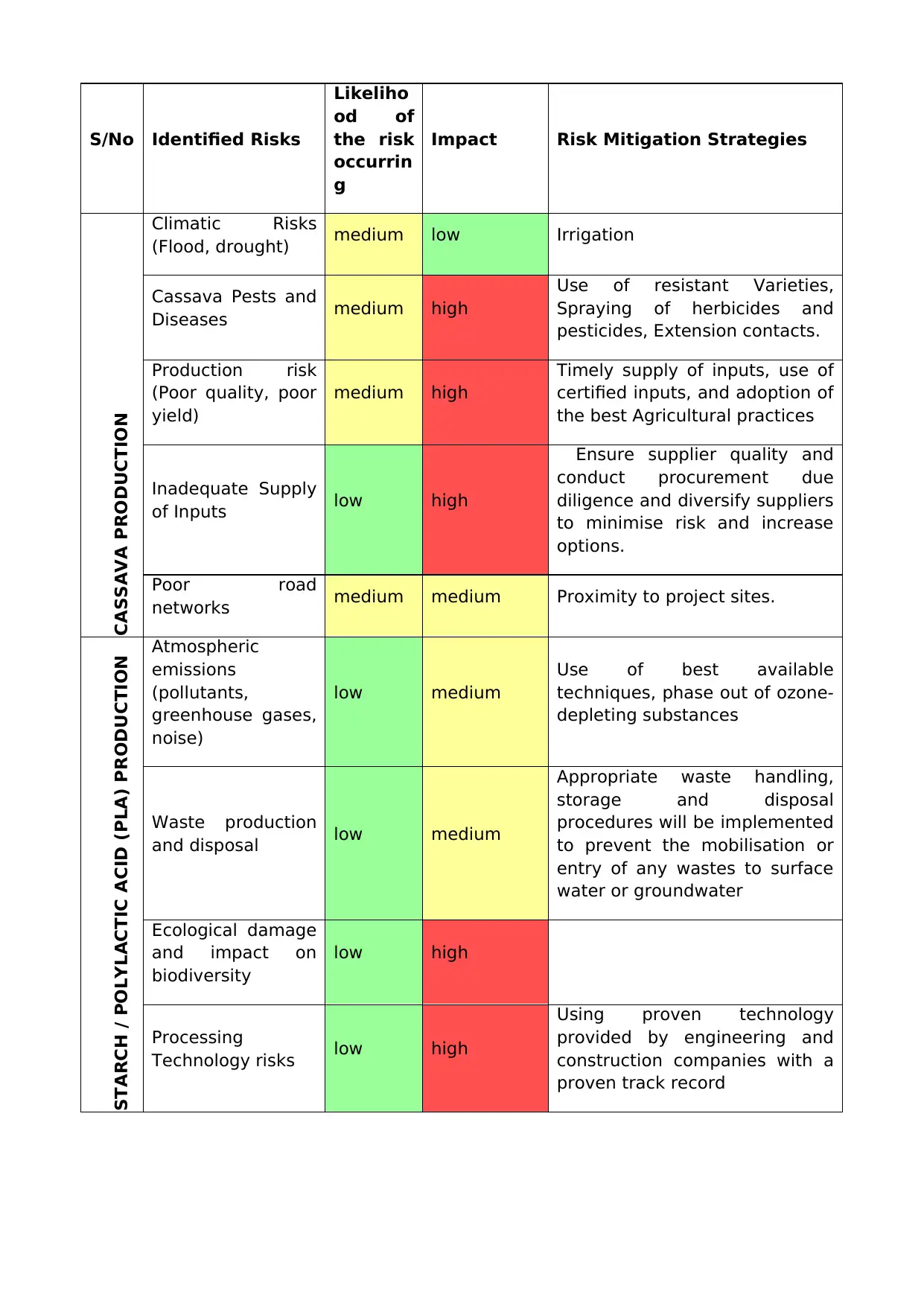
S/No Identified Risks
Likeliho
od of
the risk
occurrin
g
Impact Risk Mitigation Strategies
CASSAVA PRODUCTION
Climatic Risks
(Flood, drought) medium low Irrigation
Cassava Pests and
Diseases medium high
Use of resistant Varieties,
Spraying of herbicides and
pesticides, Extension contacts.
Production risk
(Poor quality, poor
yield)
medium high
Timely supply of inputs, use of
certified inputs, and adoption of
the best Agricultural practices
Inadequate Supply
of Inputs low high
Ensure supplier quality and
conduct procurement due
diligence and diversify suppliers
to minimise risk and increase
options.
Poor road
networks medium medium Proximity to project sites.
STARCH / POLYLACTIC ACID (PLA) PRODUCTION Atmospheric
emissions
(pollutants,
greenhouse gases,
noise)
low medium
Use of best available
techniques, phase out of ozone-
depleting substances
Waste production
and disposal low medium
Appropriate waste handling,
storage and disposal
procedures will be implemented
to prevent the mobilisation or
entry of any wastes to surface
water or groundwater
Ecological damage
and impact on
biodiversity
low high
Processing
Technology risks low high
Using proven technology
provided by engineering and
construction companies with a
proven track record
Likeliho
od of
the risk
occurrin
g
Impact Risk Mitigation Strategies
CASSAVA PRODUCTION
Climatic Risks
(Flood, drought) medium low Irrigation
Cassava Pests and
Diseases medium high
Use of resistant Varieties,
Spraying of herbicides and
pesticides, Extension contacts.
Production risk
(Poor quality, poor
yield)
medium high
Timely supply of inputs, use of
certified inputs, and adoption of
the best Agricultural practices
Inadequate Supply
of Inputs low high
Ensure supplier quality and
conduct procurement due
diligence and diversify suppliers
to minimise risk and increase
options.
Poor road
networks medium medium Proximity to project sites.
STARCH / POLYLACTIC ACID (PLA) PRODUCTION Atmospheric
emissions
(pollutants,
greenhouse gases,
noise)
low medium
Use of best available
techniques, phase out of ozone-
depleting substances
Waste production
and disposal low medium
Appropriate waste handling,
storage and disposal
procedures will be implemented
to prevent the mobilisation or
entry of any wastes to surface
water or groundwater
Ecological damage
and impact on
biodiversity
low high
Processing
Technology risks low high
Using proven technology
provided by engineering and
construction companies with a
proven track record
Secure Best Marks with AI Grader
Need help grading? Try our AI Grader for instant feedback on your assignments.
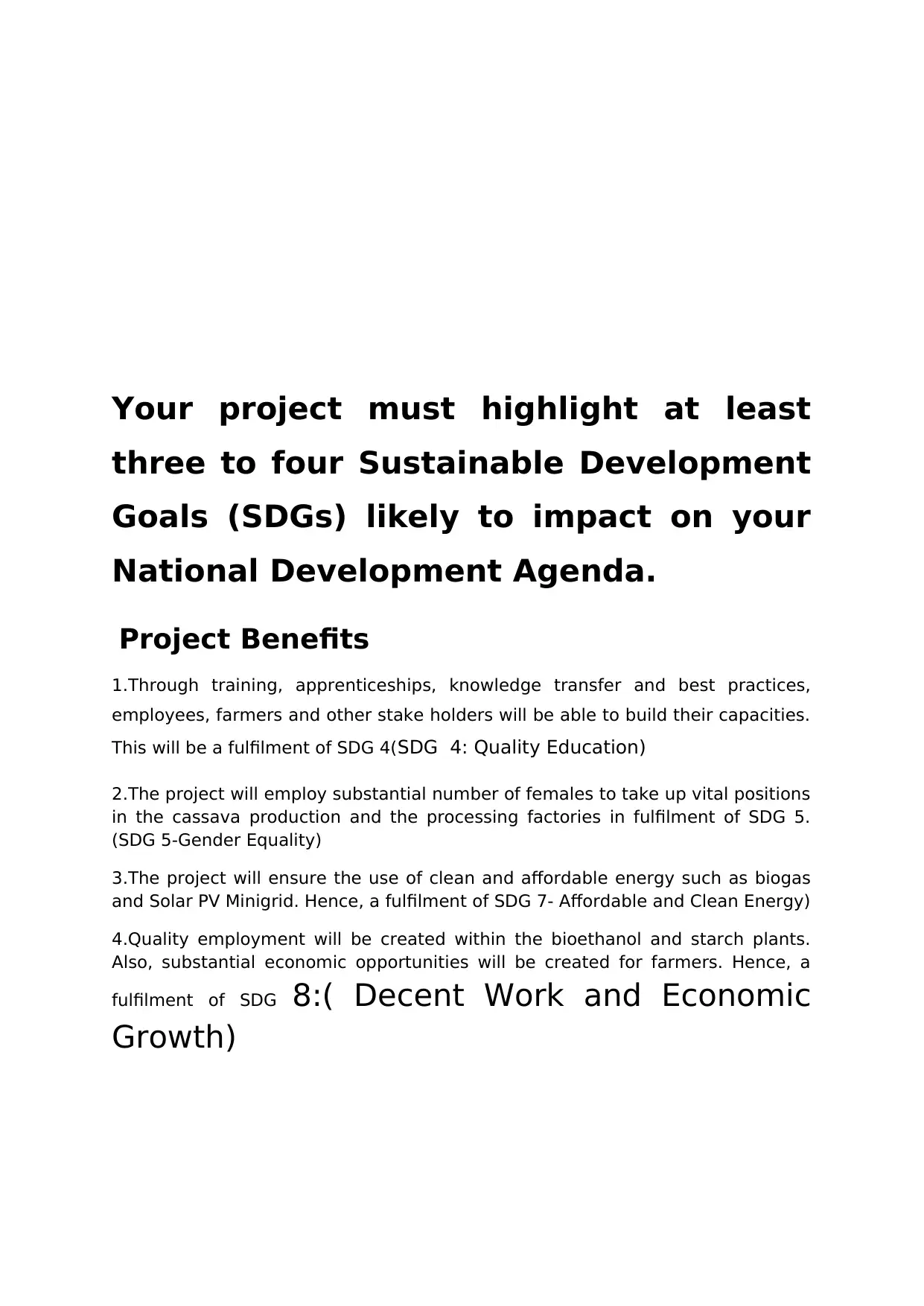
Your project must highlight at least
three to four Sustainable Development
Goals (SDGs) likely to impact on your
National Development Agenda.
Project Benefits
1.Through training, apprenticeships, knowledge transfer and best practices,
employees, farmers and other stake holders will be able to build their capacities.
This will be a fulfilment of SDG 4(SDG 4: Quality Education)
2.The project will employ substantial number of females to take up vital positions
in the cassava production and the processing factories in fulfilment of SDG 5.
(SDG 5-Gender Equality)
3.The project will ensure the use of clean and affordable energy such as biogas
and Solar PV Minigrid. Hence, a fulfilment of SDG 7- Affordable and Clean Energy)
4.Quality employment will be created within the bioethanol and starch plants.
Also, substantial economic opportunities will be created for farmers. Hence, a
fulfilment of SDG 8:( Decent Work and Economic
Growth)
three to four Sustainable Development
Goals (SDGs) likely to impact on your
National Development Agenda.
Project Benefits
1.Through training, apprenticeships, knowledge transfer and best practices,
employees, farmers and other stake holders will be able to build their capacities.
This will be a fulfilment of SDG 4(SDG 4: Quality Education)
2.The project will employ substantial number of females to take up vital positions
in the cassava production and the processing factories in fulfilment of SDG 5.
(SDG 5-Gender Equality)
3.The project will ensure the use of clean and affordable energy such as biogas
and Solar PV Minigrid. Hence, a fulfilment of SDG 7- Affordable and Clean Energy)
4.Quality employment will be created within the bioethanol and starch plants.
Also, substantial economic opportunities will be created for farmers. Hence, a
fulfilment of SDG 8:( Decent Work and Economic
Growth)
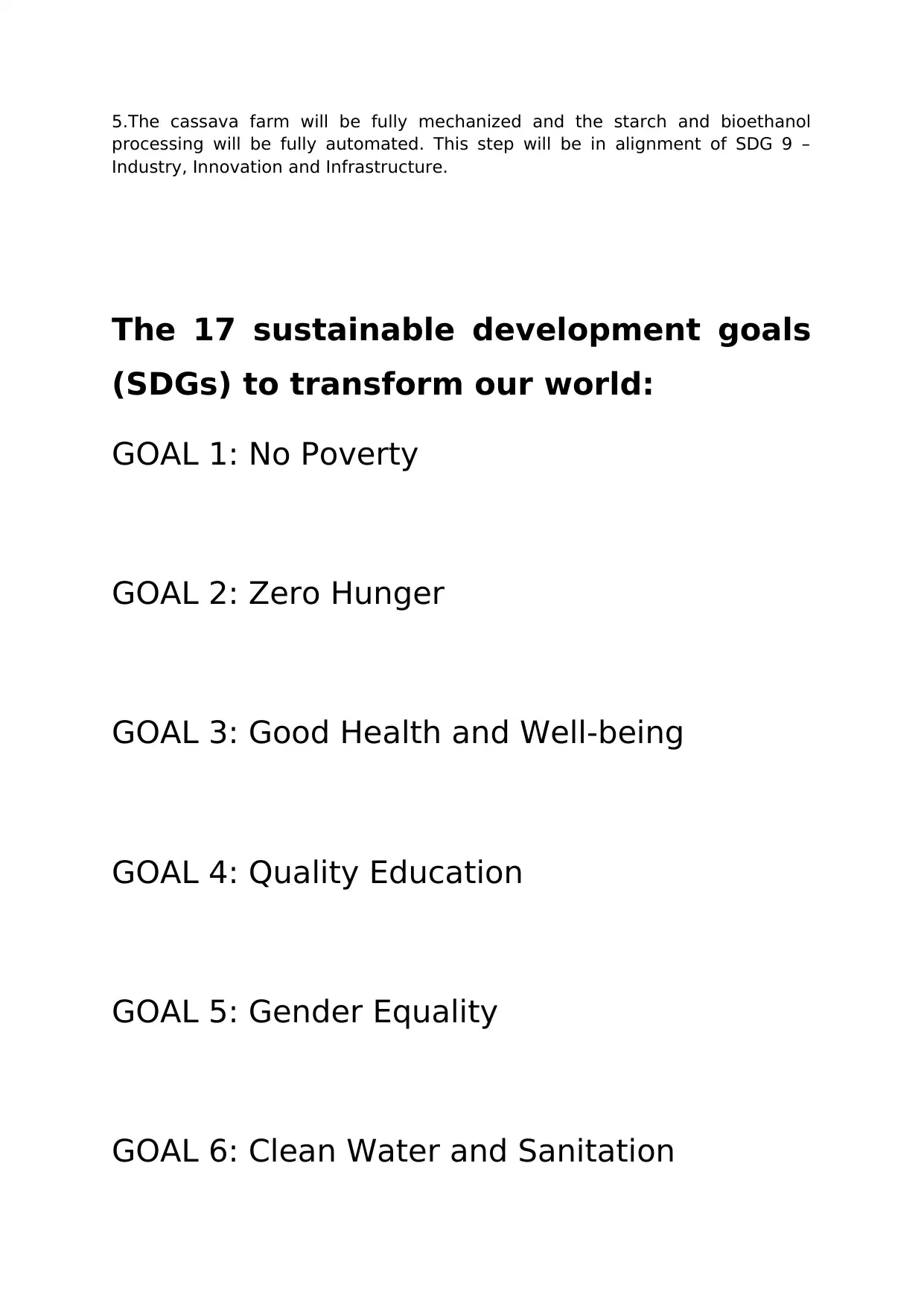
5.The cassava farm will be fully mechanized and the starch and bioethanol
processing will be fully automated. This step will be in alignment of SDG 9 –
Industry, Innovation and Infrastructure.
The 17 sustainable development goals
(SDGs) to transform our world:
GOAL 1: No Poverty
GOAL 2: Zero Hunger
GOAL 3: Good Health and Well-being
GOAL 4: Quality Education
GOAL 5: Gender Equality
GOAL 6: Clean Water and Sanitation
processing will be fully automated. This step will be in alignment of SDG 9 –
Industry, Innovation and Infrastructure.
The 17 sustainable development goals
(SDGs) to transform our world:
GOAL 1: No Poverty
GOAL 2: Zero Hunger
GOAL 3: Good Health and Well-being
GOAL 4: Quality Education
GOAL 5: Gender Equality
GOAL 6: Clean Water and Sanitation

GOAL 7: Affordable and Clean Energy
GOAL 8: Decent Work and Economic Growth
GOAL 9: Industry, Innovation and
Infrastructure
GOAL 10: Reduced Inequality
GOAL 11: Sustainable Cities and
Communities
GOAL 12: Responsible Consumption and
Production
GOAL 8: Decent Work and Economic Growth
GOAL 9: Industry, Innovation and
Infrastructure
GOAL 10: Reduced Inequality
GOAL 11: Sustainable Cities and
Communities
GOAL 12: Responsible Consumption and
Production
Paraphrase This Document
Need a fresh take? Get an instant paraphrase of this document with our AI Paraphraser
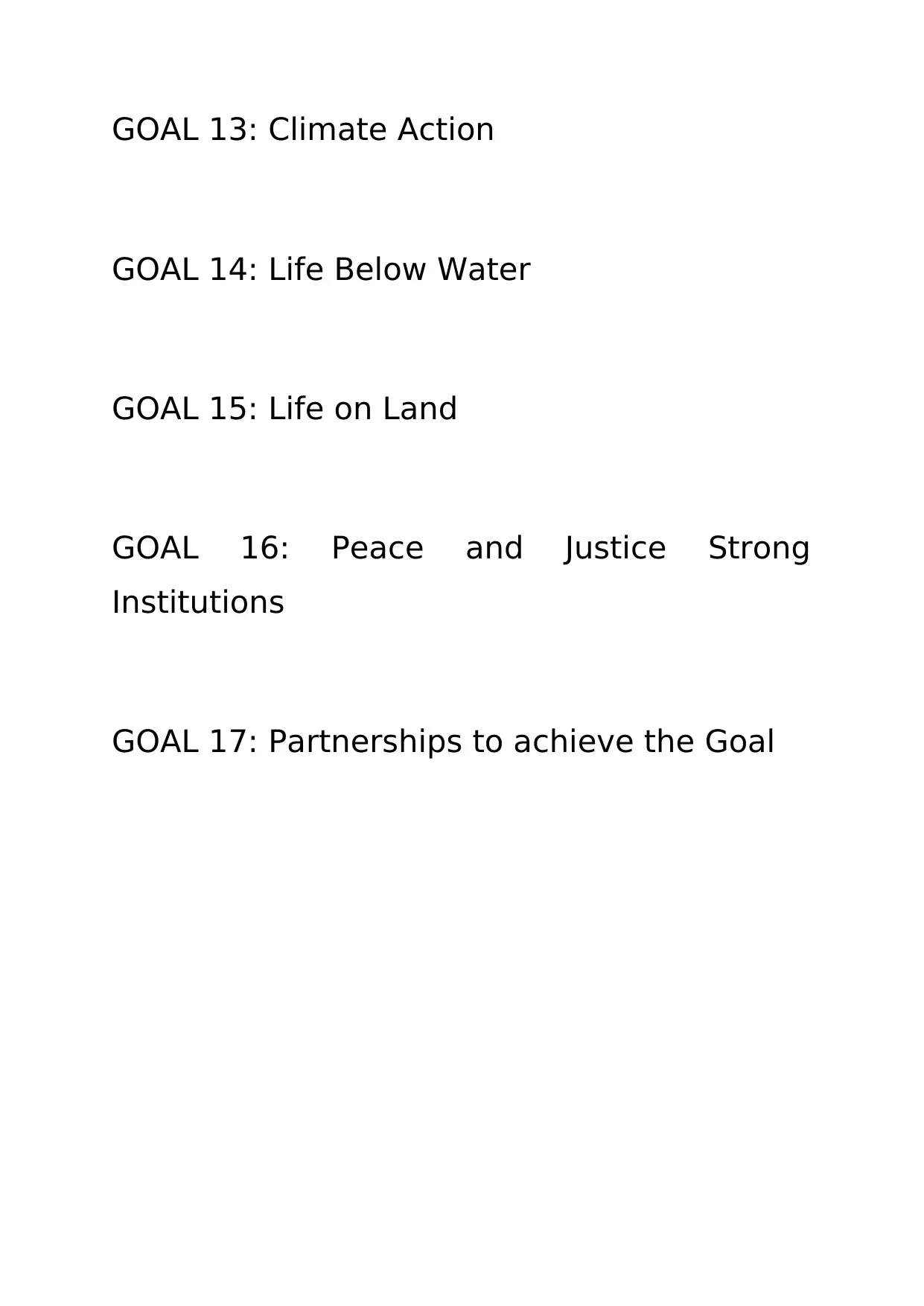
GOAL 13: Climate Action
GOAL 14: Life Below Water
GOAL 15: Life on Land
GOAL 16: Peace and Justice Strong
Institutions
GOAL 17: Partnerships to achieve the Goal
GOAL 14: Life Below Water
GOAL 15: Life on Land
GOAL 16: Peace and Justice Strong
Institutions
GOAL 17: Partnerships to achieve the Goal
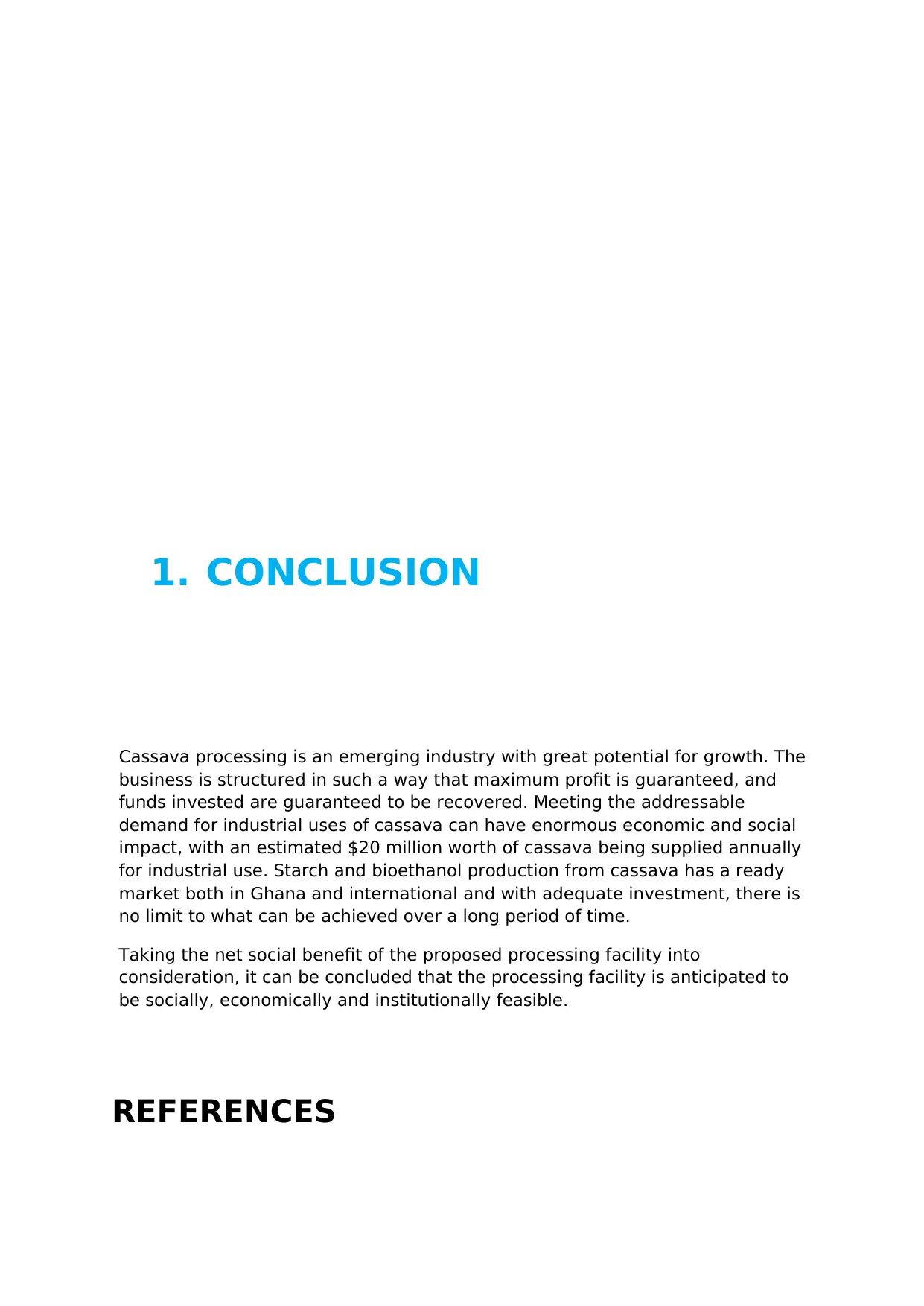
1. CONCLUSION
Cassava processing is an emerging industry with great potential for growth. The
business is structured in such a way that maximum profit is guaranteed, and
funds invested are guaranteed to be recovered. Meeting the addressable
demand for industrial uses of cassava can have enormous economic and social
impact, with an estimated $20 million worth of cassava being supplied annually
for industrial use. Starch and bioethanol production from cassava has a ready
market both in Ghana and international and with adequate investment, there is
no limit to what can be achieved over a long period of time.
Taking the net social benefit of the proposed processing facility into
consideration, it can be concluded that the processing facility is anticipated to
be socially, economically and institutionally feasible.
REFERENCES
Cassava processing is an emerging industry with great potential for growth. The
business is structured in such a way that maximum profit is guaranteed, and
funds invested are guaranteed to be recovered. Meeting the addressable
demand for industrial uses of cassava can have enormous economic and social
impact, with an estimated $20 million worth of cassava being supplied annually
for industrial use. Starch and bioethanol production from cassava has a ready
market both in Ghana and international and with adequate investment, there is
no limit to what can be achieved over a long period of time.
Taking the net social benefit of the proposed processing facility into
consideration, it can be concluded that the processing facility is anticipated to
be socially, economically and institutionally feasible.
REFERENCES

[1] Global Consumption Index. [online] Available from:
http://physics.macro.org/jstewart/101/worldconsumption.pdf [Accessed: Aug
02, 2015]
[2] Stickland, P. (30 March 2000) Tap and explore. [online] Available from:
http://word watch.org/images/blocks/offshoreaccracontractarea_tap.pdf
[Accessed: Aug, 02, 2013]
Https://www.shemenecoindustries..com
http://www.e-agriculture.gov.gh/index.php/about-mofa/extensions/srid
http://physics.macro.org/jstewart/101/worldconsumption.pdf [Accessed: Aug
02, 2015]
[2] Stickland, P. (30 March 2000) Tap and explore. [online] Available from:
http://word watch.org/images/blocks/offshoreaccracontractarea_tap.pdf
[Accessed: Aug, 02, 2013]
Https://www.shemenecoindustries..com
http://www.e-agriculture.gov.gh/index.php/about-mofa/extensions/srid
1 out of 22
Your All-in-One AI-Powered Toolkit for Academic Success.
+13062052269
info@desklib.com
Available 24*7 on WhatsApp / Email
![[object Object]](/_next/static/media/star-bottom.7253800d.svg)
Unlock your academic potential
© 2024 | Zucol Services PVT LTD | All rights reserved.
